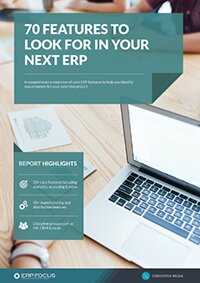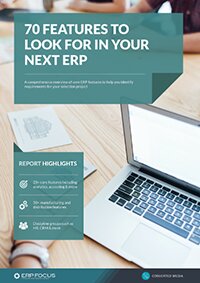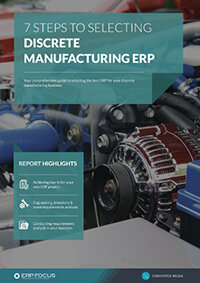Core functionalities you should look for in a discrete manufacturing ERP
There are a wide variety of discrete manufacturers. Some produce only a small number of products in low volumes and others produce many products and some of those in high volumes. But there are some common functionalities all should look for in an ERP system:
1. Cost reduction
An ERP has to help reduce costs. How will supplier management and purchasing tools help find components that deliver high quality and arrive on schedule at continually lower costs? Will scheduling and job management tools help you reduce the time to manufacture and avoid costly rework?
Recommended reading: 70 features you should consider for your next discrete manufacturing ERP purchase
2. CAD links
New products are in the pipeline. Your engineers find new designs that are easier to make and ensure components fit together just right. When the engineers find the next bread through, you want to implement it tomorrow and not wait a long time while new bills of material and routings are typed into the ERP. The tools exist now to copy those data from the drawings into the ERP with amazing accuracy and speed.
3. CAM links
Today’s discrete manufacturing ERP systems can talk to your machinery. Use those tools! Get actual production rates as jobs are in process and update your production schedule. Update scheduled deliveries for your customers at the same time. Use the most current rates when quoting your next bid. All these ERP tools will help your business be more competitive and to communicate better with customers and suppliers and in your own building at the same time.
4. Flexibility and agility
Your business is profitable today and you have steady and satisfied customers. Tomorrow is unknown but your discrete manufacturing ERP has to be able to adapt to tomorrow to help ensure your business stays successful. Maybe today you specialize in short-run production but your best customer asks you to produce a new product that requires long-run production. Your ERP needs to handle the change. A new material comes on the market that promises to dramatically reduce the cost of your product. Can you change over before your competition changes – and will your ERP change with you?
Working with bottlenecks
There will always be bottlenecks that control your rate of production. Your ERP should help you identify those bottlenecks and use the drum, buffer, rope methods of TOC to get the most production throughput possible until that constraint is resolved. Then quickly identify the new bottleneck and schedule around it with no delay.
Discrete manufacturing ERP should also give you visibility into available materials and capacity. They will give you the ability to communicate with the shop floor personnel so they are working on the most critical jobs. That communication needs to be two-way so management knows what they are doing and have finished doing. Dashboards with this kind of information can be available to users so that your whole enterprise is working always as a team.
Free white paper

70 features to look for in your next ERP
A comprehensive guide to help you identify requirements for your ERP selection

Featured white papers
-

7 steps to selecting discrete manufacturing ERP
17 pages of ERP selection advice and industry requirements analysis
Download
Related articles
-

How to identify the best ERP for your discrete manufacturing business
Learn about the best practices associated with selecting a discrete manufacturing ERP system for ...
-

Secret KPI: Why Your ERP Implementation Team Matters More Than Software
Learn how Godlan ensures successful ERP implementation for manufacturers with proven strategies &...
-

A compliance checklist for medical manufacturing ERP
These are the compliance requirements your medical device manufacturing ERP should help you meet

